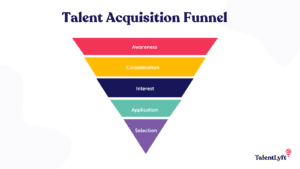For those who work in Marketing and Sales, the funnel concept is already an old acquaintance. For a few years now, however, this little word has also become part of the daily lives of HR professionals, based on the recruitment funnel methodology.
If you haven’t heard about this strategy yet, know that it has enormous potential to facilitate the processes of hiring professionals in the market – especially for positions that have high demands, such as IT vacancies.
So that you don’t miss out on this trend, from now on we will explain more about how the recruitment funnel works and show you how it can help your company attract the best IT candidates.
Throughout this article you will learn:
- What is a Recruitment Funnel
- Recruitment funnel stages
- How to Create a Recruitment Funnel for IT Professionals
- What are the benefits of having a recruitment funnel?
Good reading! ☺
What is a Recruitment Funnel?
In general, the recruitment funnel (also known as the recruitment and selection funnel) has as its main objective to help HR understand the process of hiring new professionals as a whole, based on clear metrics.
It is a graphic representation of the stages of recruitment and selection, which favors the analysis of each phase of this process – from attraction to hire – with a wealth of details.
Through the recruitment funnel, it is possible, for example, to know how many people participated in the selection process and at which stage there was the greatest evasion of candidates. Thus, it is easier to identify points of improvement and, consequently, to build an increasingly better process.

Recruitment funnel stages
As in the Marketing and Sales areas, the recruitment and selection funnel is also divided into three main stages. Next, we will give more details about each of them:
Top of funnel
This stage of the funnel contains information from the first stages of recruitment, that is, attracting candidates and screening CVs.
Here, the company’s mission is to attract the best talent and thus ensure the quality of hires at the end of the recruitment funnel. But for that to happen, you need to put a series of actions into practice, such as:
- Have a good careers page;
- Advertise vacancies in the correct channels;
- Drag the job description;
- Have a good Employer Branding strategy.
After the attraction, you will need to do the initial screening of the resumes, a phase that can be optimized with the help of technology, as we explained earlier in this article on “Smart Recruitment”.
A good metric to analyze at this time is the percentage of qualified candidates will be for the next stages of the selection process. After all, this can bring interesting insights into the effectiveness of your attraction strategies.
Middle of the funnel
In the middle of the recruiting funnel are, mainly, the testing and interviewing phases of successful candidates in the initial screening.
There is a range of strategies that can be adopted on this front, ranging from remote tests to validate technical skills, cultural and dynamic fit tests, as well as online or face-to-face interviews.
The golden tip here is to find a model that not only meets but also delights, the candidate profile sought to fill the vacancy, in order to ensure that he really wants to be part of the company.
Bottom of funnel
The funnel bottom, in turn, includes the stages of selection and hiring of the talent most compatible with the open position.
Based on all the previous steps, HR, together with the area manager, must make the final decision on which candidate is most prepared and, therefore, will receive the job offer.
When the strategies of the top and middle of the funnel are well structured, there is a great chance that the chosen professional will accept the proposal and become part of the team.
How to Create a Recruitment Funnel for IT Professionals
So far, you could know the main steps that make up a traditional recruiting funnel, right?
That alone brings some interesting insights into how you can start creating your own recruiting funnel. Still, we have prepared some additional tips to assist in this process…
The first point you should know is that there is no fixed recruiting funnel structure. This means that it can change according to the complexity of each vacancy.
However, when we talk about the recruitment and selection of technology professionals, there are some phases that are considered fundamental.
Check out the main metrics that should be recorded and monitored in this case, divided by funnel stage, in order to make your selection process even better:
Top of funnel
- Number of visitors to your careers page (if any);
- Total number of people who applied for the position;
- The total number of candidates who were qualified in the initial screening.
Middle of the funnel
Number of candidates approved in technical and cultural fit tests;
Number of candidates approved in interviews with HR and area managers;
Bottom of the funnel
- Number of finalist candidates, to be chosen according to the company’s tie-breaking criteria;
- The number of people approved and hired at the end of the selection funnel.
- With all this data in hand, it is possible to have a more strategic view of which steps are bringing good results and which ones need to be improved.
For example, when the volume of candidates attracted in the first stage is very low, this can be a sign that the Employer Branding or job promotion strategies need to be improved.
To reach an assertive conclusion on what your strengths and weaknesses are, you need to understand how to calculate the recruitment funnel. A good way to do this is by calculating common metrics and comparing them to average values.
Tip: we have specific content about the main metrics in HR that should be tracked. Be sure to check it out to further improve your strategies! ☺

What are the benefits of having a recruitment funnel?
As you’ve seen so far, the recruitment funnel came to help HR better understand all the steps that make up the hiring of new professionals.
By doing so, it brings numerous advantages to companies, such as:
- Monitoring the candidate’s journey, which allows for the constant improvement of the recruitment and selection stages;
- Decision-making based on reliable metrics;
- Greater reliability in hiring people, which helps to reduce turnover among new hires;
- Alignment of future employees with the company’s culture, among others.
When the benefits listed above come together, they boil down to more agility and assertiveness, in addition to cost reduction, for the recruitment and selection of people – which is precisely why so many HR professionals are already betting on this tool.
We hope that with the information gathered here, you will be able to start a successful recruitment funnel strategy in your company and, thus, obtain all the advantages that this methodology is capable of bringing.
To receive more content focused on the recruitment and selection of technology professionals, be sure to subscribe to our Newsletter.
Also, if hiring a developer is a priority to you and your company, click the button below and fill out the form.














